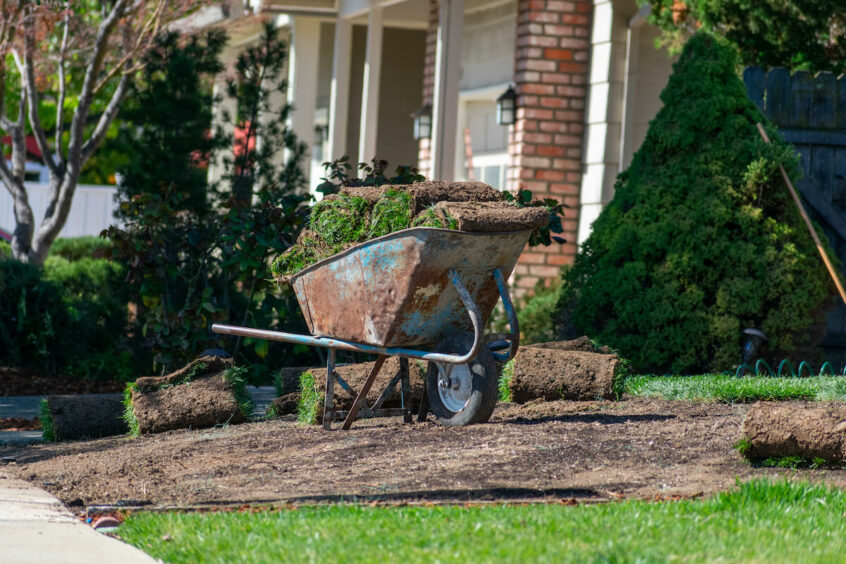Measuring your yard’s square footage is an essential step when buying sod. It helps you to determine the amount of sod required for your lawn, which in turn helps you to calculate the cost of sod and the quantity of soil, fertilizer, and other materials that you may need. In this blog post, we will explain the process of how to manually measure your yard’s square footage for buying sod.
If you’d rather use an app or an online tool, there are plenty out there! Online apps such as MeasureMyLawn use Google Maps data to view land lots. Then, you plot the points of your lawn and the app does the calculations for you. However, there are some cases where a digital program may not be the simplest way to measure your square footage. For example, if your property is irregularly shaped, if it has several sloped regions, if you have multiple landscaped areas that won’t need sod, if you have mature trees blocking the aerial view of your property, or if your property isn’t up to date on Google Maps — then it’s worth it to do manual measurements. Below, we cover the steps on how to manually calculate your sod square footage requirements!
How to Measure for Sod
Step 1: Prepare the tools
Before you start measuring, you need to prepare the tools required for the job. You will need a measuring tape or a walking measuring wheel, a pencil, and a piece of paper to write down the measurements. You can also use a digital measuring tool or a smartphone app that can measure distances. Whatever method you choose, be prepared to repeat your measurements at least one more time. Our adage for buying sod is to measure twice, order once!
Step 2: Divide the yard into sections
The next step is to divide your yard into sections. You can do this by drawing a rough sketch of your yard on a piece of paper. Divide the sketch into rectangular or square sections, and give each section a number. This will help you to keep track of the sections and their measurements. If your lawn is a simple square or rectangle, you can simply measure the entire thing as one section. However, if you have garden beds, trees, water fixtures, ponds, sheds, or other areas that won’t need sod, dividing the lawn into sections will help you get the most accurate square footage measurements.
Step 3: Measure the length and width of each section
Using the measuring tape, measure the length and width of each section. Start at one corner of the section and measure the distance to the next corner. You should be measuring along the side of the section, NOT on the diagonal. Write down the length measurement on the piece of paper. Then, measure the distance from the other corner to the opposite side. Write down the width measurement on the piece of paper. Repeat this process for all the sections.
Step 4: Calculate the area of each section
To calculate the area of each section, you need to multiply the length and width measurements. For example, if a section is 10 feet long and 8 feet wide, the area would be 10 x 8 = 80 square feet. Write down the area measurement on the piece of paper next to the section number.
Step 5: Add up the areas of all sections
Once you have measured and calculated the area of each section, add up all the areas to get the total square footage of your yard. For example, if you have four sections with areas of 80, 120, 100, and 60 square feet, the total area would be 80 + 120 + 100 + 60 = 360 square feet.
Step 6: Add a margin of error
It’s always a good idea to add a margin of error of around 10% to your total square footage. This will give you some leeway in case you make any mistakes during the measuring process. It’s also a good idea to order a little extra sod to account for any irregular shapes or corners in your yard.
Step 7: Order your sod
Once you have calculated the total square footage of your yard and added a margin of error, you can order your sod. Sod is typically sold by the square foot, so you can simply multiply the total square footage by the cost per square foot to get the total cost of your sod. You can also ask your sod supplier for advice on the amount of sod you need and the best type of sod for your yard.
Legacy Turf Farms offers online ordering and fast local sod delivery for all of our different sod varieties. Our sod is sold by the pallet — each pallet is 500 square feet.
Check out our online shop for more details at https://legacyturffarms.com/shop/.
Sod Care Resources
Need help caring for your new sod? Not to worry! We have plenty of new sod installation and care tips available through our blog.
If you’re getting ready to install sod for the first time, check out our post here on How to Prepare Your Yard for Sod. We’ve included instructions on how to prep your soil in order to give your sod the best possible start and to help it get established quickly.
On the fence about what kind of sod to buy for your home? Whether you’re looking for a Zoysia or a Bermuda Grass, one of the most important factors to consider is whether or not your sod is certified. At Legacy Turf Farms, we always recommend buying Georgia-certified sod to reduce the chances of insects, pests, weeds, and lawn diseases. Check out our article on Why Buying Certified Sod Matters to learn more about certified sod.
